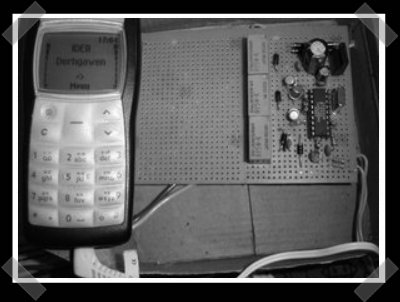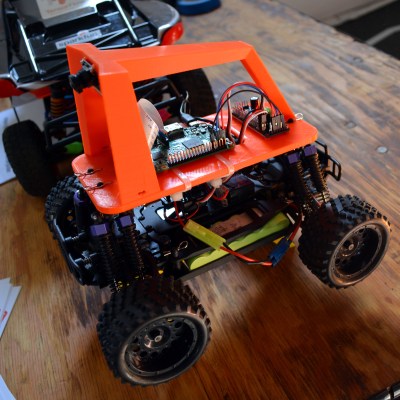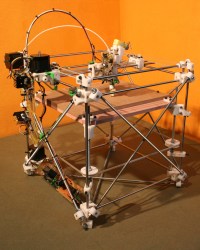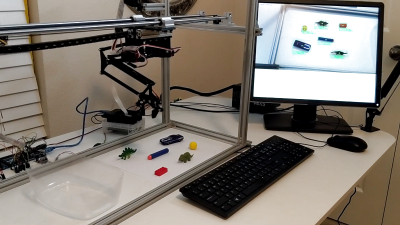Today marks exactly 15 years since Hackaday began featuring one Hack a Day, and we’ve haven’t missed a day since. Over 5,477 days we’ve published 34,057 articles, and the Hackaday community has logged 903,114 comments. It’s an amazing body of work from our writers and editors, a humbling level of involvement from our readers, and an absolutely incredible contribution to open hardware by the project creators who have shared details of their work and given us all something to talk about and to strive for.
What began as a blog is now a global virtual hackerspace. That first 105-word article has grown far beyond project features to include spectacular long-form original content. From our community of readers has grown Hackaday.io, launched in 2014 you’ll now find over 30,000 projects published by 350,000 members. The same year the Hackaday Prize was founded as a global engineering initiative seeking to promote open hardware, offering big prizes for big ideas (and the willingness to share them). Our virtual connections were also given the chance to come alive through the Hackaday Superconference, Hackaday Belgrade, numerous Hackaday Unconferences, and meetups all over the world.
All of this melts together into a huge support structure for anyone who wants to float an interesting idea with a proof of concept where “why” is the wrong question. Together we challenge the limits of what things are meant to do, and collectively we filter through the best ideas and hold them high as building blocks for the next iteration. The Hackaday community is the common link in the collective brain, a validation point for perpetuating great ideas of old, and cataloging the ones of new.
Perhaps the most impressive thing about the last 15 years of Hackaday is how much the technological landscape has changed. Hackaday is still around because all of us have actively changed along with it — always looking for that cutting edge where the clever misuse of something becomes the base for the next transformative change. So we thought we’d take a look back 15 years in tech. Let’s dig into a time when there were no modules for electronics, you couldn’t just whip up a plastic part in an afternoon, designing your own silicon was unheard of, and your parts distributor was the horde of broken electronics in your back room.
Open Tools and Open Knowledge
The most transformative thing we’ve seen over the last 15 years is the free availability of knowledge, and the availability of platforms to share it back again (pay it forward if you will). Rewind to the turn of the millenium and the modus operandi in the electronics industry was still very much to get a college degree, hone your craft on the job, and keep that knowledge locked up as a trade secret. But of course with the maturation of the Internet that model was disrupted.
Tools like SourceForge — founded in 1999 — were a product of the dotcom boom and provided a place to freely host sourcecode. This made it a lot easier to stand up smaller projects and work on them as a team. It provided code to study, and suddenly anyone with time and interest could begin to learn the secret world of computing.
At the same time, niche communities began to come alive, using platforms like phpBB, the open source forum software which was released in 2002. Now we could break the isolation of being the only geeks on the block and start supporting one another.
It was a perfect time for the hackers to unite and in September of 2004, Phillip Torrone published the very first Hackaday article on the “Red Box” hardware hack for spoofing coin drops in pay phones.
Silicon for the Masses
These were still the bad old days; it was difficult to source parts and even when you could get them they were usually quite expensive. Who here remembers printed catalogs from component distributors? Well that’s not the end of the world, some still swear by ordering their parts from the pages of dead trees. The real problem was lack of inexpensive components packed with features.
Microcontrollers were certainly around, having made huge advances in the 1990’s to shed the ultraviolet shackles in favor of EEPROM. But it was the automotive and consumer electronics industry that did us the most favors. More devices meant manufacturing at a much larger scale. As demand ramped up, processes shrunk down to achieve more devices per wafer. This drove the cost of production down, and more players began to enter the field. By the mid-2000’s ordering microcontrollers in single quantities was becoming cheap and easy. What still lagged behind far behind were sensors — today we’re spoiled with cheap IMUs and sensors for everything from relative humidity to electrocardiography — but that’s quite a recent development.

The cellphone contributed more than its fair share of technological trickle-down. I’d wager the majority of people reading this have fond memories of playing snake on a Nokia 3310 — they seem to have manufactured billions of them but actual numbers are closer to 125 million. We saw a ton of hacks using 3310 screens, and whether you salvaged them from an old phone or bought replacements. From that brick to dawn of smartphone, demand for MEMs sensors and high-quality cameras signaled the dawn of cheap components thanks to economies of scale.
As billions of phones were sold throughout the world, they drove the development and production of myriad chips. From accelerometers to GPS modules, fingerprint readers to Bluetooth radios, advanced designs quickly became cheap and now. At the same time, tools grew up around these parts. ATMEL’s offerings were pulled into avr-libc in 2004, resulting in an entire toolchain in the open source world. It wasn’t long before Arduino leveraged this openness to build out their hardware and software platform, making it even easier for people to come in and try their hand.
Computers Got Really Small, and Internet Got Really Easy

If you needed something more than an 8-bit microcontroller in 2004, you had to do silly things like strap a beige box with a Pentium II inside (III if you were lucky) to your project. Industrious hackers realized that routers were small computers and the OpenWrt project was founded the same year Hackaday started. This was Linux but greatly slimmed down for the resources available on these boards. But of course the huge upside was that this brought Ethernet and WiFi to the party, along with a standard serial port off which you could hang additional hardware.
A lot of clever things happened with router boards — which is good because we used them for years. There was hunger for better Linux, and easier connectivity. Sure, you could buy WiFi dongles but you needed a USB stack to use them and that didn’t exist outside of computers. During that time cellphones became smartphones, and in the process there was less hardware hacking and more software hacking. The HTC Dream, released in 2008, was the first Android phone — again with Linux running under the hood but more importantly with an inviting development environment that begged to be the front-end for hardware hacks.

The BeagleBoard came hot on the heels of the first Android phones, and in 2012 the Raspberry Pi blew out the price floor and ushered in single-board computers as a platform. These transformative events took our microcontroller-dominated world and turned it upside down, as actual Linux machines challenged on size, power budget, and cost. The computing power previously locked into the smartphones had now come out to play. It became downright normal to build your own internet-connected devices packed with computing power. And when you didn’t need all that computational power, the ESP8266 WiFi chip came along in 2014 to provide wireless connectivity on a budget. We entered a truly civilized time.
Build Your Own CNC Machine Tool Was Unheard Of
Hey wait a minute, all this talk about bits but what about the atoms? Here’s a parallel story. While we love old iron just as much as the next gal, the mechanical engineering story during Hackaday’s existence is just as interesting.

Back in the 1990’s, some big players in manufacturing began using additive manufacturing techniques to build plastic parts one layer at a time. Some ingenious hackers looked at that and asked why not? The RepRap project was born in 2004 and 3D printing was available to anyone with a few hundred dollars and an intro to someone willing to print the parts that weren’t threaded rod, NEMA motors, and belts.
But a 3D printer is nothing without firmware and software, and the community wrote G-code interpreters (ReplicatorG, Sprinter, and then Marlin) that fit on inexpensive microcontrollers. On the host computer, Skeinforge and then later Cura and Slic3r completed the toolchain from 3D model to printed plastic. Meanwhile, in the CNC world, the EMC project (later LinuxCNC) spun off of an NIST-developed G-Code interpreter for big computers and Grbl did the same for microcontrollers.

Precision rod, acme screws, and aluminum extrusion all existed, but good luck getting them in those bad old days. But the demand was there, and precision hardware prices dropped into the fertile open-source firmware and software ecosystem. 3D printers, home-built CNC mills, and even DIY lasercutters like the Lasersaur flourished into the world we now take for granted where anything that you can model on a computer can be made physical in no time.
Power Tech: Up in the Air and Down in Your Pocket
Readers of a certain vintage will cringe when I murmur chemical formulas like NiMH and NiCad. The rechargeables that every 80s and 90s kid had in their RC cars were a bastion of disappointment — dead every time you pull the toy out of the closet, and flat from mere minutes of use immediately after a full charge.

We complain about Lithium-Ion battery technology not moving ahead fast enough, but it’s absolutely transformed what we can do with portables. There are two major realms here, the portable tech like cellphones that have pushed the size and weight limits below anything imaginable, and the high-load applications that pack incredible power density in a brick the size of… a brick.
For the hacker, this means we’ve not only moved away from internal combustion RC aircraft, but reinvented flying vehicles in the form of quadcopters (drones if you must) that benefit from both low-weight batteries, brushless DC motors that are insanely powerful considering their diminutive size, and a revolution in the available power FETs and motor controller silicon that makes them all go round. The adoption of Li-ion batteries in phones and toys led to cheap chips that handle all of the charge and discharge details so you don’t have to.
Custom Chips, We’re Coming for You!
It’s easy to tell what the immediate future will bring. We’re in the age of ASICs — custom chips made for specific purposes. The hacker’s introduction to this comes in the form of FPGAs. Although they’ve been around for a long time already, the LUTs per dollar is insanely cheap at this point, and thanks to a massive reverse engineering effort, open toolchains are now available.
As for designs themselves, silicon is no longer a black box. RISC-V is an open source hardware instruction set architecture — basically the core of a microcontroller. The game with “open” projects is that there’s always a lower layer that is proprietary, but we do our best to push that boundary lower and low. Having seen the birth of chips based on the RISC-V design, that line is now at the chip-fab level and at this point, any individual can build their own custom processor around the design and run it in an FPGA as a proof of concept. If it’s really good, and you’re really lucky, it could even become a custom chip some day and that barrier will likely become lower and lower over time.
Viva la Hackaday
We live in amazing times, but of course they are ever-changing. A couple thousand words to recap fifteen years of Hackaday just isn’t enough. That’s why we wrote all of those articles in the first place!
We do it because we’re hackers and we all love reading Hackaday. So when you find that awesome thing and want to share it with someone, send it on over. Whether it’s your creation, someone else’s, an interesting new part, or a piece of engineering news that deserves a deep dive, Hackaday’s the place to begin your search and join in the conversation. Thank you for being there throughout the years. With your help, we’ll continue to be the daily news of the hacker hive-brain for another fifteen years!
















And now someone needs to hack up a nice cake.
We’re planning on something fun for the Friday night party during SuperCon ;-)
A cake in the shape of the Jolly Wrencher?
And similar to a King’s cake of New Orleans, it will have a surprise inside (Arduino? 555? RasPi?)
I’m thinking they’ll get a raspberry pie instead of cake
15 years, yeah, was just thinking that’s about how long I’ve been reading daily. Didn’t realize I’d been reading since near the beginning but apparently I have.
Keep it up guys, I still love the site
555 pls
Rather than just cake, how about a Jello/Jelly Wrencher?
Or, a Jolly Rancher Jolly Wrencher?
B^)
Congratulations! Keep up the great work!
Congratulations on surviving fourteen years of people complaining that HaD was better in the old days! :D
Oh em gee – this comment was better in the old days. (ツ)
Happy Anniversary HackADay .. Hackaday? hackaday? HackaDay?
It would have been nice if you had spelled Phillip Torrone’s name correctly…
Oof, thanks for pointing that one out, fixed!
Happy Birthday, Hackaday! My favorite website for many years now. Ar this point, I have spent a significant portion of my adult life on these pages, but I can honestly say I’ve learned so much from this resource over the years. I’ve appreciated the community and the education I’ve received from reading up on the wide variety of hacks, news, or other tidbits I have stumbled on here. The knowledge shared here has been useful in my hobby as well as career, and I am still turning people on to this site anytime I get the chance.
Thank you, for being awesome!
I agree 100% – Happy Birthday HaD!
Me too, thanks HaD and Congrats!!!
I first heard about HaD when opening up the I-Opener and Websurfer was all the rage.
I’m sadly not a long time reader, but still, thank you for existing.
I was here in the early days. What I told the founders was they are ruining my life because I need to review what comes out daily. But seriously it is my way to stay on top of things that is happening out there. I don’t read all the stories but do look at all the titles and read a good many stories each day.
Congrats!!
hi folks, we’re going to have a live video chat with past and present hackaday folks tonight, details are here: https://blog.adafruit.com/2019/09/05/hackaday-turns-15-today-live-video-chat-today-at-8pm-et-hackaday-hackadayio-adafruit/
(pt, hackaday founder, and maker of the logo, etc)
Did you spell your name right?
B^)
So, did you ever build the ram jet engine? B^)
https://hackaday.com/2004/09/11/make-a-ramjet-engine/
Wow, very neat.
Happy to have been a small part of things here. The site and community has definitely had a huge impact on my life!
Happy Birthday HackADay!
You are now old enough to get your Learner’s Permit!
I’ve been with you pretty much since 2007 or so…
I hate to think how much of my life has been spent either on Hackaday, or going down rabbit holes Hackaday has guided me to. But time enjoyed or in education is not time wasted, and I am grateful, thank you.
Looking forward to the article where the HAD editors predict the next 15 years… :-D I wonder if we will have an “edit” button? ;-)
An “edit” button, in 15 years?
Dream on!
B^)
Instead of editing a posted comment, just make a following content that upsets the Political Correctness of the editors, they’ll delete it, and maybe the preceding comment as well. Maybe you could ask them to do that in the followup comment.
Then re-post your corrected comment!
B^)
Absolutely incredible work over the past 15 years! Congratulations!!! I’m an active reader and IO contributor for almost ten years now and check you guys out multiple times per day! By far by favorite source of inspiration!
We truly live in a great time with people like Limor Fried, Phillip Torrone, Ben Heck, Jeri Ellsworth and so many others out there. I remember learning how repair TV’s with my uncle when I was 8 in the 70’s and that ignited my passion for tech and in some degree, software . Back then you have Radio Shack with its fuzzy yellow carpeting, and until the late 70’s I could go to Lafayette Electronics. Then I would take a short trip to the Boston area where You Do It Electronics in Needham was and a surplus place I forget in Lynn, Massachusetts plus the Tri State computer shows.
Thanks for all the advances and all the tech we take for granted.
Happy to say that You-Do-It in Needham is still going strong!
The Boston area was loaded with places, into the seventies at least. Meshna’s, Poly-Paks, I think B&F, there were others. A couple of times about 74-75 when we were camping in Maine, I talked my mother ibto going to that area, so I did see PolyPaks and Meshna’s in person, rather than through ads. They existed because there was manufacturing there, and hence surplus. I guess many of the places died iff as the owners retired, or the surplus dried up.
I also had some really good submarines from the area during those trips.
Michael
There was also “Eli Heffron’s” in Cambridge and “Computer Warehouse Store” in Kenmore Square. The MIT flea market is still going strong and is perhaps the best source of surplus stuff in Boston. “You blew it” is a nightmare of high prices and bad selection, only for the desperate.
There is still plenty of electronics manufacturing going on in Boston, the lack of surplus is due to modern “JIT” manufacturing methods that don’t result in excess inventory. Also, the proliferation of inexpensive new electronic gear has made old slow stuff less interesting, even if it is super cheap.
“The Boston State-House is the hub of the solar system. You couldn’t pry that out of a Boston man, if you had the tire of all creation straightened out for a crowbar.” – Oliver Wendell Holmes
Oh!
And a smooth shout out to Evil Overlords…
Thanks for keeping the lights on!
Oh, and Mike,
nice article.
I like your progression, and how you kept major developments (mostly?) separate.
Hackaday to you.
Hackaday to you,
Hackaday everyone,
Hackaday to you.
Hip, hip! Hooray!
Hip, hip! Hooray!!
Hip, hip! Hooray!!!
Why were they born so beautiful…….. 😄
Hacking since 11 years old in 1961, but what you guys gave given me and so many others is the conduit to share, and above all the feeling of pride in my hacking achievements, some published (Thanks) and many not. Now a fully recognised sub species, Homo erectus hackadayensus. 👍
Many thanks for years of good stuff. I think I’ve seen a fairly large percentage of it.
I am starting second year Electronic Engineering because of you people. (Really wish I could move from buying parts to building projects though)
I can’t believe i’m the first to reply this, but, this is not a hack😂
Congrats HaD!
So how many of those 903,114 comments were, “Not a hack!”?
PS: Not a hack! ;)
What a wild ride it’s been!
I remember as a kid, struggling to figure out how the toolchain for a Rabbitcore ethernet chip was supposed to work, and giving up on it. The BASIC Stamp was around, and good for what it was, but interpreted performance was just waiting for someone to come along and eat its lunch.
As PCs were shedding their legacy I/O ports, I remember a great little project called the Serial Wombat, which was a preprogrammed 40-pin PIC that spoke a nice protocol and basically became the “arms and legs” of your interfacing project. Very much like you’d do with StandardFirmata today. You weren’t meant to run your own code on the PIC, it was just there to provide gobs of GPIO, UART, ADC, drive LCDs and servos, read rotary encoders, etc, all in the provided firmware.
Then of course the Arduino sprang into existence and ate all their lunches and then some.
Does anyone remember, before the WRT54G, there was a project called OpenAP? It ran on the USR2450, which was an embedded-486 inside, and a Prism2 PCMCIA wifi card.
It took some work to build, and ISTR needing a PCMCIA SRAM card to bootstrap the installation, but once flashed, you had a real busybox Linux running kernel 2.4.17 or thereabouts!
I’m nostalgic for those days, but I don’t really miss ’em…
Congratulations!
We want some words from famous Brian Benchoff regarding this wonderful anniversary … nobody can so well insult the entire readership and yet, we loved him. I hope he wasn’t thrown under the bus.
Agreed, I miss that cranky hack.
I always looked forward to Brian’s posts. They had a lot of “personality”.
So, what is the conversion rate on Benchoff Bucks now?
All the best wishes, Hackaday!
Been reading for most of your 15 years, and here’s to another 15 (at least).
Don’t change anything, it’s awesome as it is.
Congratulations again from me in Australia,
Mr Name Required
15 years and HaD still doesn’t have an Edit button for the comments.
Congrats!!
Happy Birthday HAD! This is the web site I go to first every day. Keep up the good work.
Happy birthday HackADay!
And Happy Birthday to HaD users too.
I’m glad to come here almost every day and always find something interesting to read.
Cheers!
Can we get a link to the first page of the blog in here, be a nice walk down memory lane, without have to page by page back 15 years..?
I guess you missed the link in the article, where it says.
“It was a perfect time for the hackers to unite and in September of 2004, Phillip Torrone published the very first Hackaday article on the “Red Box” hardware hack for spoofing coin drops in pay phones.”
So, re-read the article, and when you come across that sentence, click on the highlighted hypertext.
In fact I did, short breaks, but what I meant was first blog page.
Lunch break, gave me a chance to dig it out.
https://hackaday.com/blog/page/4868/
I’m sorry I misread your comment.
I specifically remember the “add a car cig lighter to your PC” lol wow how time flies in the 2Ks!
I started reading/viewing/commenting somewhere in 2005 at least that’s the furthest I could find a HAD bookmark icon in my firefox boomark bar backups. I love this site and will continue to read until either the site expires or I do <3 Viva La HAD! Thanks for a great 15 years guys!
Usually when things don’t work, we find the settings mentioned above are not correctly applied (the virtual machine settings and the storage type setup